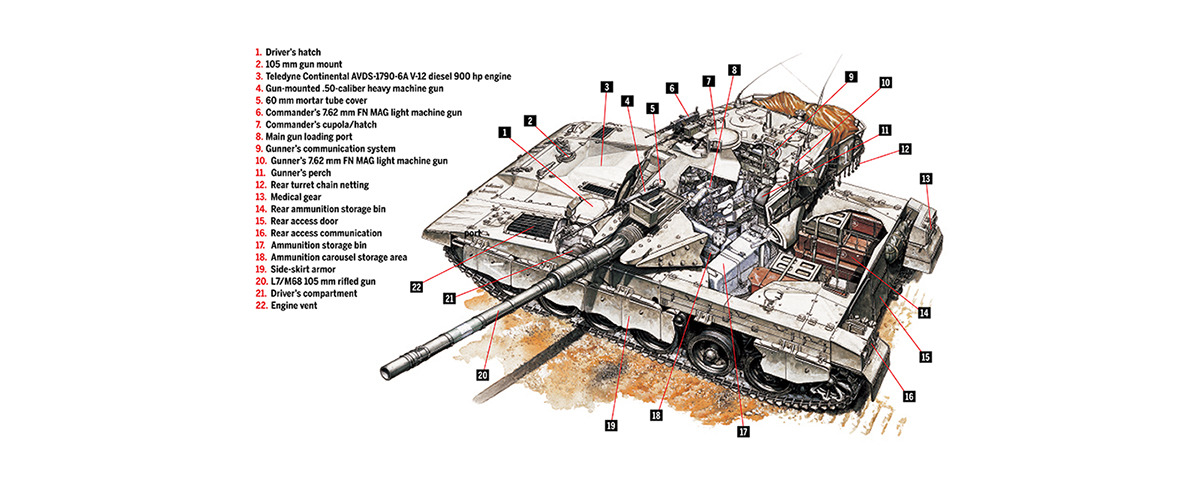Crew: Four (commander, driver, gunner, loader)
Combat weight: 70 tons
Length (including gun barrel): 29 feet 7 inches
Width: 12 feet 2 inches
Height: 9 feet
Ground clearance: 18 inches
Engine: Teledyne Continental AVDS-1790-6A 908 hp V-12 air-cooled diesel
Transmission: Ashot Ashkelon hydromechanical automatic, four gears
Max speed (off-road): 34 mph
Fuel capacity: 370 gallons
Operational range: 310 miles
Armor: Classified composite, sloped modular design
Main armament: L7/M68 105 mm rifled gun
Secondary armament: Two modified 7.62 mm FN MAG light machine guns; 60 mm mortar; optional gun-mounted .50-caliber heavy machine gun; optional Mk 19 40 mm grenade launcher
Ammo capacity: 105 mm (62 rounds), 7.62 mm (10,000 rounds), .50-caliber (2,500 rounds)
As Israel developed an armored corps, it faced the quandary of acquiring weaponry from an outside world devoid of trustworthy sources. The grim losses it suffered during the 1973 Yom Kippur War—with 1,500 of its more than 2,500 dead being tankers—underscored the dire need for a tank capable of both protecting its crew and taking on the best Israel’s Arab enemies sent against it. Under the direction of Maj. Gen. Yisrael Tal, the Israelis set to work on an indigenous design, virtually every component of which would be produced by Israeli manufacturers. The resulting Merkava (“Chariot”) Mk I debuted in 1979.
Inspired by the close-range battles waged with Syrian armor in the Golan Heights, the Mk I was designed primarily to protect its crew, with an angled turret to deflect shots, spaced armor to counter shaped-charge rockets, and the engine in front to provide further protection. The rear of the spacious hull was fitted with a door for replenishing ammo, accommodating ground troops or aiding in emergency evacuation. The Mk II added chain netting to protect the rear turret from anti-tank rockets, as well as add-on armor plates and, later, Blazer explosive reactive armor. Such innovations first proved their worth during the 1982 campaign in Lebanon. In their first encounter with Syrian T-72s the Merkavas destroyed eight without a loss. Of the seven Merkavas destroyed, six succumbed to mines, the seventh to a barrage of RPG-7s and SA-3 wire-guided missiles.
Since then the Israel Defense Forces has kept the innovative tank competitive, boosting power and speed in the Mk III and Mk IV, as well as adding bolt-on modular armor that can be quickly replaced if damaged or when upgraded. With such enhancements the IDF properly lays claim to one of the world’s most formidable battle tanks. MH





